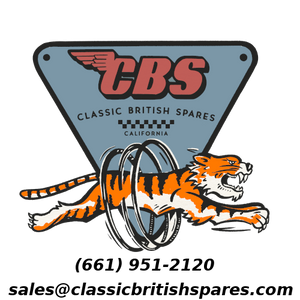
Tech W/ Kyle: Inlet Manifold Repair (Triumph 3TA)
Work on my 1963 Triumph 3TA is slowly coming along
Last week I got my cylinder barrel back from boring and painting and the week prior I finished the bottom end along with the gear box
I have the small port (7/8") 3TA / T21 head and I found the proper manifold in my old stock pile
I noticed that there was a crack down the casting parting line that needed to be addressed prior to installing mew studs
In today's post I will cover how to fix and salvage this manifold
Lets dive in
The problem

At some point a PO (previous owner) tried to jam a 5/16" X 18 stud down a 5/16" X 22 dedicated hole
Doing so caused the stud to go in "sideways" and make a crack down the parting line
The only way to fix this problem would be to remove the stud, bore the hole and have it TIG welded then onto drilling and tapping the newly welded hole
As you can above, the parting line is visibly cracked..
The fix (various steps)
I'm sure there are other ways to perform this fix, however I decided to go this direction
The first task was to remove the existing stud and toss it in the bin
I took recording of the hole depth to be able to mimic how deep the bore is after it has been welded
I lapped the bottom and top surfaces on my lapping plate to ensure both sides are perfectly flat

I then made a simple tool in my lathe from 3/8" cold-roll steel to act as a pilot
This pilot tool will help me locate the 2 stud holes to ensure that the mill spindle is parallel to the 2 carb mounting holes
The small end of the pilot was approx .265" as the casting holes where oversize from 1/4"..
This was done from the factory to take up any "misalignment's

Once the locating / pilot tool was made I mounted my inlet manifold to my milling table
I used the tool to make sure the manifold was parallel
After the manifold was parallel on both sides, I took my test indicator and indicated off the 1 existing stud to find the center of the opposite hole
When the center of the stud was found, I zeroed out my "x-axis" and went in 2"
2" is the carb spacing on Amal flange mount carbs
Now I know that my stud is 2" and that the opposite hole will be in line to each other

I used a 3/8" end-mill to bore the hole round and removed all existing threads
I noticed that the crack was still there, to address this, I used a 3/16" end-mill and bored a slot until the crack was gone and no longer visible
Now the manifold is ready for TIG welding

Back from the welder I noticed that there was weld spots on the gasket surface which gave me some "wiggle room"
Mount the manifold on the table and repeat the steps above (check for parallelism, find center of stud, go in 2", etc)
First was to "face" the gasket surface flat while leaving approx .002" to lap in after the machine work
The spec of the hole will be the same as original which is 5/16" X 22 which calls for a 17/64" drill bit according to online sources
Bored the hole then tapped the hole

I used my Dremel to contour the sides then finished off with a Scotch-Brite wheel to blend it all in
I used my lapping plate again to lap both sides of the manifold to finish the surface
Head over to the lathe to make a custom 5/16" X 26 X 5/16" X 22 stud for the newly bored hole
A little blue Loctite and this job is done

Thanks for reading
Thank you for reading today's Tech Tip post W/ Kyle
Have something to say? Drop us a comment in the section below
Click here for more posts like this one
Ride safe!

Classic British Spares
@John – Thanks for reading and for the comment. I have never seen a figure – TIGHT is all I can offer
Classic British Spares
@Lindsay – Thank you for commenting and thanks for reading. The work I do as shown above is for sharing and for learning purposes. I do not weld, bore or do that line of work. In fact, a lot of shops do not do any work in house. I am open to learning new things, perhaps soon I’ll get there
John Adamick
Kyle,
I’m new to your company and your tech tips. The above is very well done and provides insight into the proper way to repair similar problems that people may run across on other components.
On an unrelated but technical matter, do you know how I can find the proper torque to apply when installing exhaust port adaptors into a Triumph 650 cylinder head?
Thanks in advance for any advice you may be able to provide.
Best regards,
John
Anonymous
Kyle, thanks for sharing this procedure. Good stuff. You mentioned outsourcing the cylinder-barrel boring, painting, and the aluminum welding. I was under the impression that Classic British Spares did that work in-house.